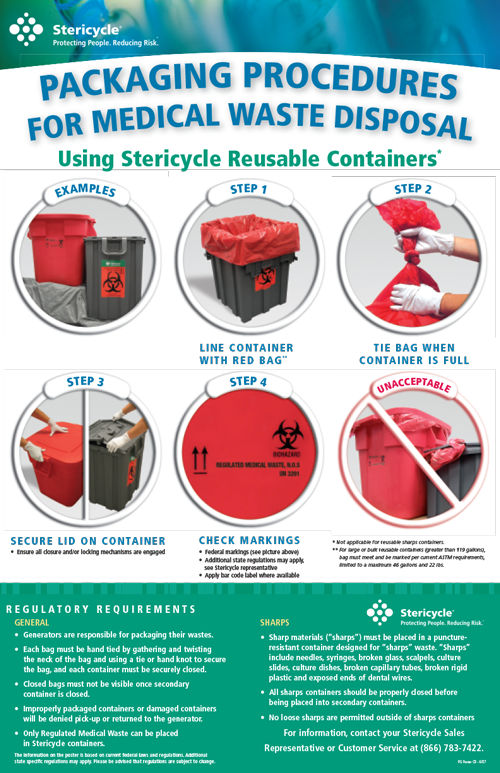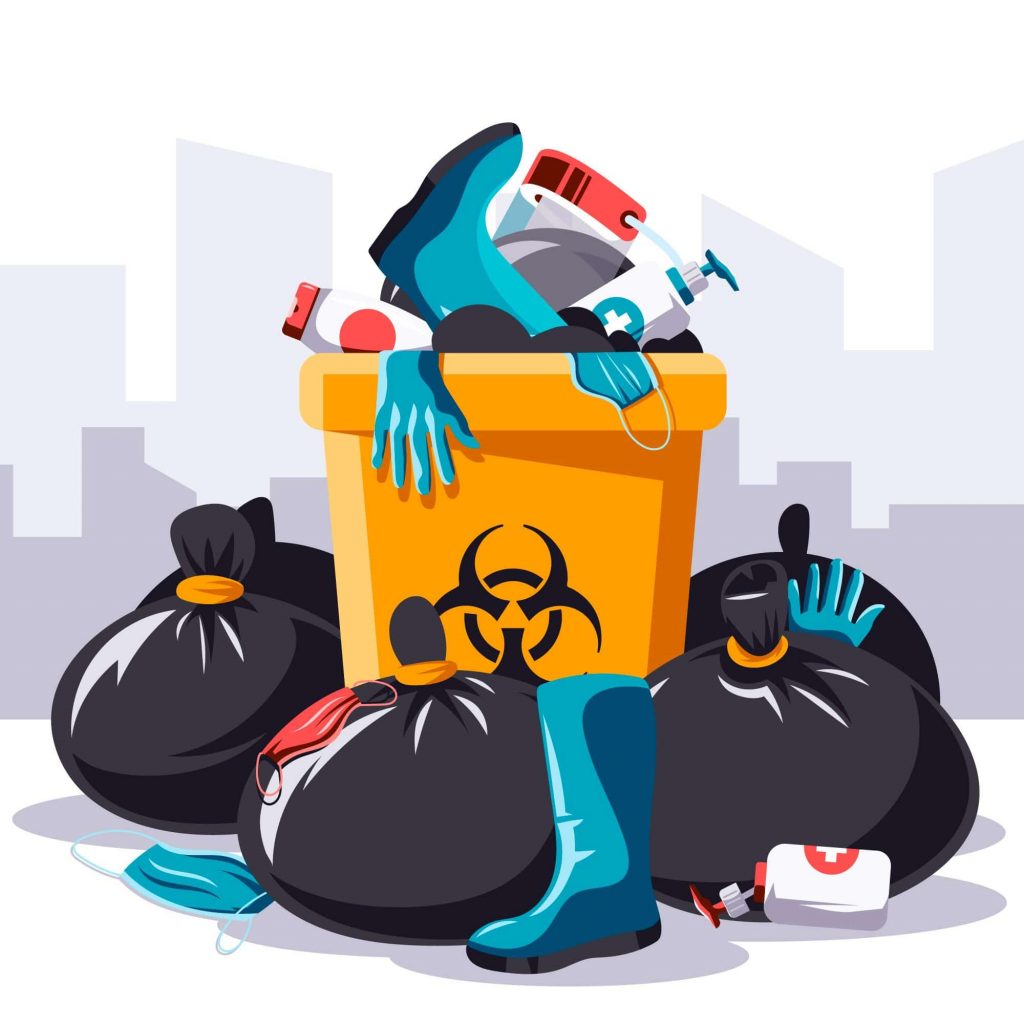Conformity and Regulations for Medical Garbage Disposal
Compliance and laws for medical garbage disposal play an important function in ensuring the safety and health of both health care specialists and the public. Proper management of medical waste is important to stop the spread of infections, shield the environment, and preserve public health. This requires adherence to certain standards and protocols stated by governing agencies and bodies. These laws encompass numerous facets, consisting of the category and segregation of clinical waste, appropriate storage and dealing with procedures, as well as transport and disposal approaches. By complying with these regulations, medical care facilities can minimize the risk of contamination and possible injury to people and the environment. This post will certainly check out the relevance of conformity and give an overview of the crucial regulations regulating medical garbage disposal.
Importance of Conformity
The importance of conformity with regulations for medical garbage disposal can not be overstated. Appropriate disposal of medical waste is vital for ensuring the security and wellness of medical care employees, patients, and the public. Clinical waste, which includes things such as made use of needles, contaminated gloves, and biomedical waste, can pose major health risks if not handled and thrown away correctly.
Conformity with policies makes sure that medical waste is taken care of in a way that lessens the possibility for direct exposure to contagious illness and hazardous materials - medical waste removal. It aids stop the spread of infections, such as HIV, hepatitis B and C, and other bloodborne pathogens. Compliance likewise plays an essential function in protecting the setting by protecting against contamination of water sources, dirt, and air
Failure to follow guidelines can result in extreme consequences for healthcare centers, including penalties, legal activity, and damages to their track record. Furthermore, non-compliance may compromise the health and wellness of medical care workers, individuals, and the community.
Compliance with regulations for medical waste disposal needs adherence to particular standards and protocols. These might consist of appropriate segregation, product packaging, labeling, and storage of medical waste. It additionally entails making use of authorized disposal methods, such as landfilling, autoclaving, or incineration, depending on the sort of waste.
Governing Agencies and Bodies
Governing firms and bodies play a vital duty in managing conformity with laws for medical garbage disposal. These companies are liable for establishing standards, procedures, and guidelines to guarantee the proper and risk-free handling of clinical waste. They check and apply conformity to protect public wellness and the environment.
One of one of the most popular regulative firms in the United States is the Epa (EPA) The EPA is accountable for managing the storage, transportation, treatment, and disposal of medical waste. They establish guidelines for waste generators, transporters, and treatment centers to comply with, making certain that all needed safety measures are taken to avoid the spread of illness and contamination.
An additional important regulatory body is the Occupational Security and Health And Wellness Administration (OSHA) OSHA sets policies and requirements to protect employees from work dangers, consisting of those pertaining to clinical waste. WasteX Medical Waste Disposal. They offer guidelines for the risk-free handling and disposal of clinical waste to safeguard workers in medical care facilities
Along with these government firms, specific states likewise have their own regulatory bodies that supervise medical garbage disposal. These firms may have their own certain laws and needs that have to be complied with.

Category and Partition of Medical Waste
To ensure proper monitoring of clinical waste, it is important to identify and segregate it according to established protocols and guidelines. medical waste disposal service. Classification and segregation play a critical role in lessening the risk of infection, shielding the environment, and guaranteeing the security of medical care workers and the general public
Medical waste is categorized right into various categories based on its prospective hazard level. These categories consist of contagious waste, pathological waste, sharps waste, pharmaceutical waste, chemical waste, and radioactive waste. Each classification needs specific handling, disposal, transportation, and storage space methods to reduce the risk of direct exposure and contamination.
Partition of medical waste entails separating different kinds of waste at the resource. This process guarantees that waste with various danger degrees is not blended, reducing the possibility for cross-contamination and making disposal procedures a lot more efficient. Appropriate partition is accomplished via using color-coded containers and tags, which aid medical care workers and waste administration personnel deal with each kind and recognize of waste properly.
Along with classification and segregation, healthcare centers must additionally abide by regional, state, and federal guidelines regarding clinical waste administration. These regulations outline certain needs for storage, transport, treatment, and final disposal of clinical waste, making sure compliance and keeping public health and wellness and safety and security.
Correct Storage and Managing Procedures
Proper storage and managing treatments play an essential duty in making certain the certified and secure management of medical waste. Clinical waste, that includes items such as utilized syringes, polluted gloves, and ran out drugs, can position serious wellness and ecological risks if not dealt with correctly. It is crucial for health care centers and various other generators of clinical waste to apply strict storage and handling methods.
To begin with, clinical waste should be kept in long lasting, watertight containers that are specifically developed for this purpose. These containers need to be classified with the global biohazard symbol and the words "clinical waste" to plainly show the materials. Additionally, the containers ought to be kept firmly near to prevent any prospective leak or spillage.
Additionally, it is essential to set apart various kinds of medical waste to prevent cross-contamination. Sharps, such as scalpels and needles, need to be stored in puncture-resistant containers to decrease the risk of injuries - WasteX Medical Waste Disposal. Chemical waste, such as disinfectants and solvents, need to be stored individually from other kinds of medical waste to avoid dangerous exposures or chemical responses

Transportation and Disposal Methods
Medical care centers should make certain the risk-free transport and correct disposal of their clinical waste to abide by guidelines and secure public health. Transport and disposal techniques play a critical role in stopping the spread of contagious diseases and lessening the environmental impact of medical waste.
To carry clinical waste, healthcare facilities must utilize puncture-resistant and Website leak-proof containers that are identified with the biohazard icon. These containers must be securely sealed to avoid any kind of leak during transport. Furthermore, medical care facilities should establish methods for the transportation process, consisting of the use of experienced personnel and dedicated lorries.
As soon as the clinical waste gets to the disposal facility, it undertakes various methods of therapy. One usual approach is incineration, which involves melting the waste at high temperature levels to ruin microorganisms and lower the quantity of waste. An additional technique is autoclaving, which makes use of vapor and pressure to sanitize the waste. After treatment, the waste is generally sent to a land fill or a waste-to-energy facility for final disposal.
It is crucial for healthcare facilities to work with accredited and permitted waste administration business to make certain correct transport and disposal of clinical waste. These business have the knowledge and sources to handle medical waste securely and in conformity with policies.
Conclusion
To conclude, compliance with policies for medical garbage disposal is of utmost significance to guarantee public health and safety. Governing firms and bodies play a crucial role in enforcing these regulations. Appropriate category and segregation of clinical waste, along with adhering to proper storage space and taking care of treatments, are crucial to protect against contamination and the spread of diseases. Appropriate transportation and disposal techniques need to be implemented to decrease ecological effects. Generally, adherence to compliance and laws is necessary to successfully take care of medical waste.
Clinical waste, which includes items such as utilized needles, contaminated gloves, and biomedical waste, can position severe health threats if not taken care of and disposed of effectively.
These groups include transmittable waste, pathological waste, sharps waste, pharmaceutical waste, chemical waste, and contaminated waste.Segregation of medical waste includes separating various types of waste at the source. Appropriate segregation is accomplished via the use of color-coded labels and containers, which help health care workers and waste monitoring workers recognize and manage each kind of waste properly.
Chemical waste, such as disinfectants and solvents, ought to be kept individually from various other types of medical waste to prevent chemical reactions or harmful direct exposures.